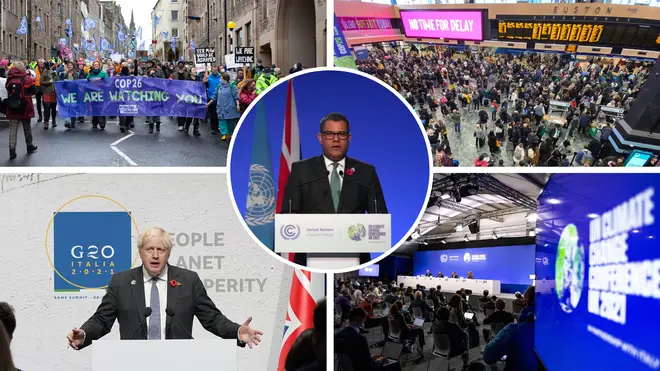
Oli Dugmore 4am - 7am
31 October 2021, 18:22 | Updated: 31 October 2021, 18:24

The first day of COP26 began with downpours in Glasgow and ended with hundreds of passengers - desperate to head north for the UN summit - prevented from travelling because of a fallen tree on the line.
A metaphor perhaps for what’s ahead in the next two weeks? Those already in Glasgow are desperately hoping not.
Prime Minister Boris Johnson is already turning up the heat - "if Glasgow fails the whole thing fails, and the Paris agreement will have crumbled" was his message to world leaders before they departed Rome and the G20, in their private jets of course, heading for Scotland.
Read more: PM warns of climate crisis: 'If Glasgow fails, the whole thing fails'
Read more: 'Ridiculous': 'People 'ironically' forced to fly to COP26 due to extreme weather

LBC's Scotland Political Editor explains what we can expect from COP26
In Glasgow, the COP26 President, Alok Sharma, was singing from the same grimly determined hymn sheet. "Paris promised, now Glasgow must deliver" was his message to delegates and the negotiators who have 13 days of hard graft ahead. It’s his job to keep them focused in the bid to keep 1.5C alive.
That’s the target behind the Paris agreement signed at COP21 - to keep global warming to that limit, with these next nine years up to 2030 believed to be key in achieving that, so there will be much focus on exactly how each country intends to meet its pledges.
Read more: Climate change: Why is 1.5C the magic number for controlling global warming?
Further there was a commitment to raise $100bn for developing countries, to enable them to cope with the damage global warming has already inflicted and to invest in new technologies so they don’t follow in the filthy fossil fuel footsteps of countries like the UK and the US. However that was supposed to have begun last year - and now the timetable has slipped to 2023. Pressure will be on to get that back on track.
Third, there is the issue of coal. In the UK there has been a recognition that the industrial revolution which was fuelled by the black stuff, generating huge wealth but also helping to heat up the planet, adds more responsibility on the UK’s shoulders. Hence the pledges to get to net zero by 2050 - 2045 in Scotland, compared to China and Russia who are aiming for 2060.

What will make COP26 a success?
Along with the EU (worst emitters being Germany, Italy and Poland), China and Russia, the other major global culprits are the US and India. President Joe Biden is struggling to get his environment bill through Congress which would ensure that net zero is met by 2050, while India has so far refused to set a date for reaching that target. Instead it has said it will reduce "emission intensity" by a third by 2030. Again it will be up to Mr Sharma to keep the Indian negotiators at the table to try and make them shift on that.
So after day one what do we know?
That the prospects of a successful COP are being managed downwards by the politicians - no doubt in the hope that any deal will therefore look more impressive. That the climate activists already at the summit are determined that their voices will be heard and more importantly listened to - expect increased protests around the site if it looks like things are going off track.
And that while optimism is not the buzz word of the moment, it is not entirely missing from the general vibe across the 64 acres of the Scottish Event Campus. As one delegate put it: "If we were not optimistic there would be no point being here."
Oh - and haggis, tatties and neeps is being sold in the summit restaurant just to remind everyone that this massive event is being held in Scotland.